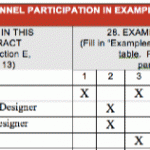
Proposal design is a challenging topic. Everybody seems to have their opinion about what your proposals should look like.
As someone trying to get a proposal out the door, dealing with proposal design can be frustrating. Especially if the people with those opinions don’t have any graphic design training.
While you understand their opinions are important, they can feel arbitrary or baseless.
So, today I’m going to give you the three golden rules of proposal design. But first, let’s discuss what your design should do for you.
The Purpose Of A Proposal Design
Proposal design is like dressing appropriately for an interview. The job of the design is to “get out of the way.”
Nobody says, “This candidate was a terrible fit. But they dressed so nice; we made her CEO.”
Similarly, when evaluating proposals, nobody says,
“They had the wrong approach, no relevant experience, and their price was way too high…” “…but when we saw the cover of their proposal, we just had to give them the $50M contract.”
That has never happened.
However, we have to accept the fact that our world is not perfect.
Some people (stupid people), will not hire you because your look isn’t “professional” enough for them. And I know firms have been “dinged” because their proposal cover depicted a conceptual design the audience didn’t like.
So, when it comes to designing a proposal you need to focus on getting out of your own way. You want it to look professional, be easy to read, and highlight the key information.
The Professional Look
Your proposal can’t be scribbled with crayons on a piece of paper. It must look professional.
What I mean by that is it should look like a document from an established business. It shouldn’t look like something thrown together by a child.
If it’s a letter proposal, it needs to look like a business letter. That means it’s on letterhead, has page numbers, etc.
If it’s a formal response to an RFP, it needs to look like a business publication (while maintaining strict compliance).
Once your proposal looks professional, that’s good enough. You don’t want to waste precious time tweaking it to perfection. If your proposal looks professional, making it look “even more professional” is not going to be a big win.
And I’ve discussed previously how you can get good graphic design for cheap.
Easy To Read
Far too often, proposal designs don’t even take readability into consideration. They’ll just have a fancy 8 or 9 point font because it “looks nice.”
Then it gets printed out and sent to the client.
What’s the age of your clients? They’ll rarely be in their 20s. They are far more likely to be in their 40s (or older).
These older clients find it hard to read your small, cool-looking font. So, what do they do? They don’t read your words. This is a case where you’ve gotten in your own way.
Readability needs to be a core consideration of your proposal design.
Highlight The Key Information
If there is an important point you want to make in your proposal, it should slap your client in the face. What I mean by that is it should be so prevalent that the reader can’t possibly miss it.
“Call out boxes” are a good option when highlighting important info.
In addition, it should be very clear where everything is. You shouldn’t have to cross reference the table of contents to find things.
The Three Golden Rules Of Proposal Design
Every proposal design must follow these general rules:
- Looks Professional
- Easy To Read
- Highlights Key Information
Ultimately, once your proposal design meets this criteria, you should move on to spend your time improving the content of your proposal.
Now it’s your turn. What features do you think a proposal design should have?
Leave a comment below.





Couldn’t agree more Matt. If you take the time to get debriefs on proposals (win or lose) and review competitor’s submissions, you will note the winners are very often not the most beautiful. Client feedback on the visual quality of the proposal is so helpful. Clear, easy to read Tables of Contents, with no more than three levels are important. Testimonials from happy clients are also a nice add in, particularly when they reference the subject of the adjacent text. I once had a client remark that one of our tab stickers was crooked which bothered him as it left an impression of a lack of professionalism… and he was right. I’ve printed all my tabs ever since! When you are rushing at the last minute and praying that the one copy of your proposal with the crooked tab sticker does not end up in the hands of the most important person on the selection committee, remember this story!
That tab story is pretty crazy. How crooked could that tab have been?!?!
That client’s mentality is insane.
Somewhere in the Looks Professional or Easy to Read categories should be “It should be proofread.” Multiple typos or grammatical errors look unprofessional and can make copy difficult to read. I’m curious to know if copy writers working on RFP responses are trending towards writing in more of a “web copy” style, e.g., copy that can be scanned vs. copy that must be read thoroughly.
I receive proposals that are often 20-30 pages. And within those pages you need to hunt for the scope and then further hunt for the fee that pertains to that scope. If the relevant project information, which is approximately 4-5 pages, was upfront and the T/C’s, etc. were in the back, the proposal design would efficiently and effectively convey the purpose of the requested proposal.
I have OFTEN thought the very same thing. It mystifies me that, in this day and age when time and people’s attention is at such a premium, RFQ’s continue to request the information in such a bassackward order.
Great points, as usual, Matt. A lot of people get so caught up in the visual design of their proposals, they miss the forest for the trees. I think the biggest issue is to make sure the prospect knows that you understand their problem (in their words, not just the marketing copy on your site for situations kind of like this), and that you have a great way to fix it that they can understand.
One nit. Readability and Comprehension are separate issues. Both are critical to winning proposals. Readability: Can the font be easily read? Some fonts are ideal for readability and should be used for Restroom signs, Titles and headlines. No fooling, sans serif fonts were invented specifically so people could find the restrooms in German train stations. Comprehension: Can the message be fully understood? Unfortunately, the fonts that score high for readability, score low for comprehension. The reasons are too complex for a comment, but serif fonts are necessary to improve comprehension of a paragraph or more. The take away: avoid unusual fonts and don’t mess with kerning and letting (spacing between lines and words). Check your choice against high comprehension publications (like the Wall Street Journal or New York Times) and you will be on safe ground.
Good point!
A reviewer once noted that one of the pages of subconsultant forms in a 200-page plus proposal was out of order in one of the copies. Another noted one word misspelled in a 100-page proposal. Rather than considering these comments “nit-picking”, I prefer to look on the positive side that at least their comments showed they paid some attention to our submittals.
I was hired in 2010 to “fix” an RFP response process and layout/production. We re-wrote the template text. I moved them to InDesign and a clean layout. I shot from a helicopter over 100 past and current projects and (ground) re-shot a lot of exteriors and interiors. Now I’m even doing our own Matterport virtual tours and 3D drone capture. I invented a 2-way (portrait/landscape) die-cut divider tab system, cover, and delivery box kit. It all looks fantastic. BUT, far too often, the feedback is: “Your proposal was the best, but your FEE/GENERAL CONDITIONS…” That pattern (a big Marketing Department effort but loss over fee/GC’s) can become frustrating/dispiriting to the Marketing Team.
I agree that graphics perfection has gotten out of hand. It’s a case of keeping up with the Jones’. Clean, simple templates get out of the way of the content so it is more likely to be read. If charts and graphs can be used to share important information, details or comparisons, that’s where the graphics effort should be. At the same time, we can’t forget the eye candy of photography. It must be professional or taken by a very good amateur. All members of the proposal team need to focus on content, from including white spaces in the layout to refining the messaging to proofreading. [BTW – a crooked tab? That reviewer was looking for an excuse to downgrade the submitting firm’s score.]